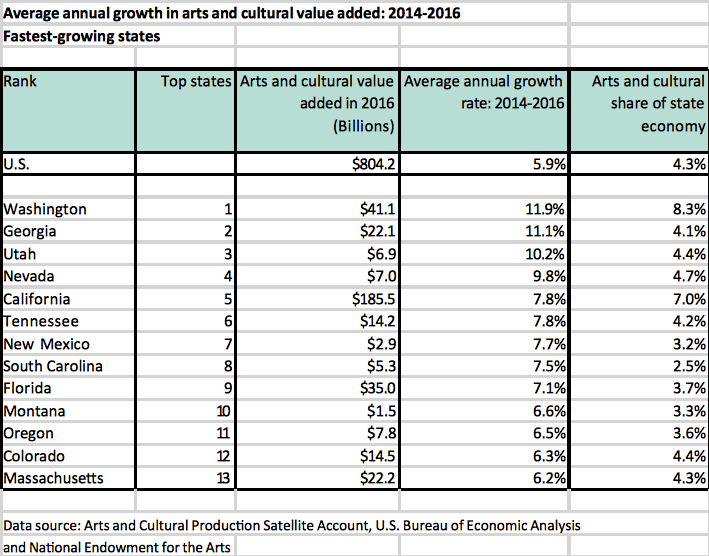Background
Dataset
Arts and Cultural Production Satellite Account (ACPSA) – state-level estimates.
Periodicity
Launched in 2013, the ACPSA is intended as an annual product. Complete state estimates, corresponding with the national account, became available in 2018.
Source/Sponsor
Partnership between the National Endowment for the Arts’ Office of Research & Analysis and the U.S. Bureau of Economic Analysis.
Research Topic
Arts economies, employment, and compensation.
Notable Features
State-level estimates of arts and cultural value-added, employment, and compensation by industry;
Location quotients (i.e., a state’s concentration of arts and cultural value-added, employment, or compensation indexed to the overall U.S. share of 1.0);
Full time-series spanning state data from 2001 to 2016.
Overview
Between 2014 and 2016, the value added by arts and culture to the nation’s economy (not adjusting for inflation) grew at an average annual rate of 5.9 percent. But in 13 states, the average annual growth rate was 6.2 percent or greater.
The arts and cultural economies grew by 10 to 12 percent in four states: Washington; Georgia; Utah; and Nevada.
In 2016, arts-related retail trade (including e-trade in books and music) added $13.3 billion to Washington State’s economy. In this state, arts-related retail trade contributed value that was 9 times greater than the U.S. average.
Relative to Georgia’s overall economy, broadcasting and performing arts presenters contributed above-average value--$6.4 billion and $369 million, respectively, in 2016.
Additionally, publishing added above-average value to Utah’s economy ($1.3 billion), while performing arts presenters contributed $848.2 million to Nevada’s Gross State Product.
Growth in arts and cultural production was also robust in Tennessee and Colorado. A significant contributor to Tennessee’s arts and cultural economy is the sound recording industry (which generated $2.8 billion in value added in 2016); in Colorado, landscape design services added more than $90 million, an amount 75 percent greater than the national index, after considering Colorado’s overall economy.


